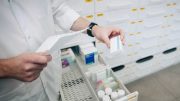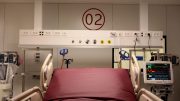Phoebe Lapine had recently spent the preceding three years, shortly after turning 32, overhauling her health to make up for her ailing thyroid, the result of untreated Hashimoto’s thyroiditis.
She was on a gluten-free diet, drinking kombucha and taking prebiotics, and finally feeling her best when she began to experience strange gut symptoms: burping between meals, stomach discomfort, and a swollen belly that refused to deflate.
She sought help from a functional specialist, who swiftly diagnosed her with small intestine bacterial overgrowth (SIBO), a gut ailment common among hypothyroid patients.
Lapine, who lives in New York, had never heard of it before, and her endocrinologist had never informed her about the risk of acquiring it. “It’s not all in my brain; the bloating is just sticking to my body like an inner tube,” Lapine, now 36, remembers thinking after receiving the diagnosis.
Treatment, on the other hand, proved to be an adventure in and of itself. Her digestion would feel normal again after six weeks on antimicrobial medications and another six months of a limited diet, and the bloat would finally go away.
In early 2018, Lapine, a food and health writer and chef, documented her SIBO journey and offered SIBO-friendly dishes on her blog and podcast. That’s when she realized how fortunate she was.
“I’ve gotten a lot of messages and emails from people who are really sick and desperate. “They’re reaching out from all over the world, saying, ‘No one knows what this is where I live,'” Lapine adds. She responded to the first few notes, but when the onslaught continued, she put up an automated response with links to internet resources.
Despite data indicates that SIBO may be a major cause of irritable bowel syndrome, it is a chronically underdiagnosed illness (IBS). IBS affects about 11% of people globally, and it’s a “wastebasket diagnosis” given to many individuals with a variety of digestive problems when doctors can’t find a more specific explanation.
Their symptoms can be controlled with a healthy diet and a few nutrients and drugs, but a cure has long been thought to be impossible. “People were told they had no choice but to ‘learn to live with it.'” Dr. Nirala Jacobi, a naturopathic doctor whose online platform “The SIBO Doctor” offers training on the illness for both practitioners and patients, believes that “when SIBO came around, it actually brought some remedies and solutions.”
However, despite Jacobi and others’ efforts to raise awareness, many practices still fall short when it comes to SIBO diagnosis and treatment. “Every day, I hear from patients who go to the gastroenterologist and it’s still not being acknowledged,” Jacobi adds.
SIBO is a condition in which bacteria or archaea—a single-celled creature older than bacteria—grow abnormally and prolifically in the small intestine. By competing for food with patients, the bacteria or archaea disrupt regular digestion. Rather than allowing the small intestine to digest food and release nutrients into the bloodstream, bacteria or archaea arrive early and ferment it.
The bacteria emit hydrogen and the archaea release methane throughout the fermentation process, giving the impression of bloating. Although SIBO has been used to describe both types of overgrowth, doctors today prefer to distinguish between the two and refer to archaea expansion as intestinal methanogen overgrowth, or IMO.
Another gas that certain bacteria can create is hydrogen sulfide, but this type of SIBO has no name. Fermentation can cause a variety of IBS symptoms, including diarrhea from hydrogen and hydrogen sulfide production and constipation from methane production, but both or neither can occur.
In addition to causing digestive pain, gas production damages the intestinal wall lining, resulting in poor fat, carbohydrate, and protein absorption, resulting in “leaky gut.” This results in vitamin deficits, the most severe of which is B-12 deficiency, which causes weakness and weariness (and in advanced cases, mental confusion).
To treat SIBO and IMO, it’s critical to understand how and why bacteria or archaea begin to overgrow in the small intestine. Despite the fact that they’re digestive problems, they’re virtually usually an indication of another problem: motility dysfunction, or food transit through the small intestine that’s too slow.
Getting to the base of the problem
Patients who call Dr. David Borenstein’s Manhattan Integrative Medicine office have often seen three gastroenterologists without success before coming to him. Treatments were either ineffective, or the SIBO or IMO reappeared after a brief respite. Relapse rates have been reported to be as high as 45 percent in other studies.
“Gastroenterologists are the majority of individuals who treat it,” adds Borenstein, an integrative and functional physician. “They’ll give you an antibiotic,” says the doctor. It works a lot of the time, but the SIBO will return because the main source of the disease isn’t being addressed.”
SIBO and IMO are easy to diagnose. A breath test is a noninvasive process that involves patients blowing into plastic tubes or bags every 30 minutes for three hours after consuming a lactulose substrate to detect hydrogen and methane gas levels (and maybe hydrogen sulfide, depending on the type of test).
It may take a few more tests to narrow out the disorders that cause SIBO and IMO, but a patient history is the best place to start.
A nasty case of food poisoning—or several—could have harmed the patient’s migrating motor complex (MMC), a mechanism that cleans the small intestine like a dishwasher every 90 minutes and, if it’s injured, can leave food particles and bacteria behind, allowing them to thrive.
The IBS Smart test checks for anti-CdtB and anti-vinculin antibodies in the blood, which are created to fight food poisoning. Their presence can imply post-infectious IBS and a weaker MMC.
Proton pump inhibitors, a type of reflux medicine that reduces the amount of acid produced by the stomach, may have harmed the stomach’s ability to destroy bacteria. In that situation, the levels of stomach acid should be tested.
Because an underperforming thyroid can cause a patient’s MMC to slow, a comprehensive thyroid panel should be performed. Abdominal surgery—a hysterectomy, a laparoscopy to look for endometriosis, a hernia—can cause scar tissue to form on the small intestine wall, pinching the intestine and obstructing flow like a kink in a garden hose. This can be detected through imaging and additional investigation.
The patient’s needs can then be met with a solution. Many of them entail the use of a prokinetic agent, which is a drug that improves motility.
In the interim, there are three options for getting rid of surplus bacteria and archaea. For SIBO, many doctors recommend a two-week antibiotic regimen—specifically, rifaximin, the first and only FDA-approved IBS treatment, or a combination of rifaximin and either neomycin or metronidazole for IMO, because archaea are resistant to rifaximin alone.
Some practitioners choose to give herbal antimicrobials such allicin, oregano, berberine, neem, and cinnamon for four to six weeks as a milder approach. Some people use the elemental diet, a liquid formula of predigested nutrients that provides the digestive tract a break while starving the bacteria or archaea in the process.
The radioactive diet is the most difficult for patients to follow, as they are unable to eat solid food or drink anything other than water for two to three weeks.
A holistic and medical partnership
SIBO research has its roots in our growing understanding of the microbiome, particularly advances made by Dr. Mark Pimentel, a gastroenterologist and executive director of Cedars-Sinai Medical Center’s Medically Associated Science and Technology (MAST) Program.
Pimentel released an article in 1999, long before the word “microbiome” became popular, demonstrating that IBS was caused by bacterial dysbiosis, or an imbalance of the gut’s microbial community, rather than a psychological disorder, as was widely assumed at the time.
Pimentel and his Cedars-Sinai colleagues have been studying the primary bacteria in the small intestine for the past two decades. They published a report last year that revealed for the first time the microbiome sequences in the duodenum, jejunum, ileum, and colon. They zeroed focused on SIBO as a significant contributor to IBS.
Allison Siebecker, a naturopathic physician who had been conducting her own SIBO study and organizing awareness campaigns in the holistic community, was drawn to Pimentel’s work.
She was one of the first SIBO professionals to launch SIBOinfo.com, an online resource with information about the illness for both doctors and patients, in 2010.
She invited Pimentel to speak at the 2015 SIBO Symposium, an annual meeting she’d started organizing a year before, when the top SIBO researchers in the United States presented their findings on the illness and therapies. Since then, Pimentel and Siebecker have continued to work.
“What’s intriguing about the naturopathic community is that they tend to see people who a lot of Western physicians can’t sort out,” Pimentel says. “I believe that was the case for IBS and SIBO in the beginning.” “The naturopathic community saw a lot of these patients and recognized the treatments earlier than Western medicine.”
While Pimentel was the first to employ rifaximin as an IBS and SIBO treatment, naturopaths like Siebecker were already promoting herbal antimicrobials as a viable alternative.
Increased awareness
Although medical schools are beginning to include more material on the microbiome and dysbiosis, practicing doctors may lack that knowledge.
Dr. Ana Esteban, an intensive-care specialist who now specializes in SIBO, adds, “I trained to be a doctor 20 years ago, and at the time, SIBO was not understood.” “No one mentioned the microbiome.” As a result, my generation is preparing the next generation of physicians.
Professionals like myself are educating oneself, but we must do it on our own dime, paying for courses out of pocket and finding the time and resources to do so because we want to. There isn’t any institutional support.”
Patients are increasingly rejecting wastebasket diagnoses and seeking out doctors who will properly examine their digestive difficulties as more online resources like Siebecker’s and Jacobi’s emerge.
According to Jacobi, “a lot of people are still urged to eat fiber and learn to live with their IBS.” “Now, thanks to the Internet and social media, people are no longer prepared to put up with it and are searching for solutions.”





